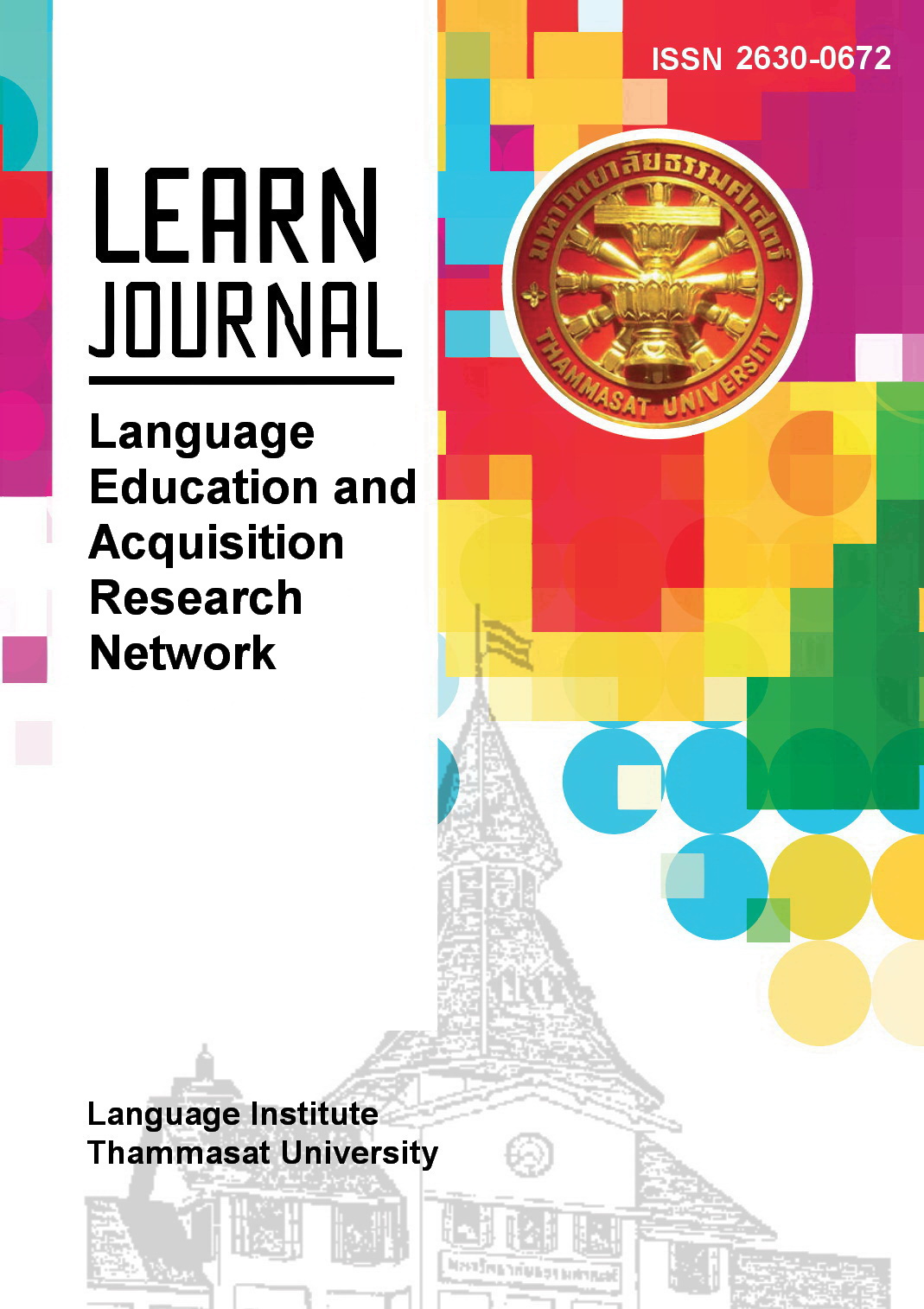Communication Apprehension and Intercultural Communication Apprehension among MA Students at a Public University in Bangkok
Main Article Content
Abstract
One important skill for 21st century people is communication. However, trait-like communication apprehension (CA) can hinder effective communication. More than that, when communicating with foreigners who come from another culture, some non-native speakers of English might also be hindered by intercultural communication apprehension (ICA). Hence, the current study investigates CA in L2 (English) and ICA among students pursuing an MA in English at a public university in Bangkok, Thailand. The research results revealed that students with higher ICA have higher CA (trait-like CA). Moreover, to be more specific, MA students in the study who have higher ICA were found to have higher CA in the dimensions of group discussions and meetings. The results provide insight into how students in the study who have different levels of ICA feel in terms of their anxiety when they communicate using English in different contexts.
Article Details
References
Beatty, M. J., McCroskey, J. C., & Heisel, A.D. (1998). Communication apprehension as temperamental expression: A communibiological paradigm. Communication Monographs, 65(3), 197- 219. http://doi.org/ 10.1080/03637759809376448
Blume, B. D., Baldwin, T. T., & Ryan, K. C. (2013) Communication apprehension: A barrier to students’ leadership, adaptability, and multicultural appreciation. Academy of Management Learning & Education, 12(2), 158–172. http://doi.org/10.5465/amle.2011.0127
Buss, A. H. (1980). Self-consciousness and social anxiety. Freeman.
Chen, G-M (2010). The impact of intercultural sensitivity on ethnocentrism and intercultural communication apprehension. Intercultural Communication Studies, 19(1). 1-9. https://web.uri.edu/iaics/files/01Guo-MingChen.pdf
Conditt, C. M. (2000). Culture and biology in human communication:
Toward a multi-casual model. Communication Education, 49(1),
-24. http://doi.org/ 10.1080/03634520009379188
Croucher, S. M., Sommier, M., Rahmani, D., & Appenrodt, J. (2015). A cross-cultural analysis of communication apprehension: A comparison of three European nations. Journal of Intercultural Communication, 38.
http://www.immi.se/intercultural/nr38/croucher.h
Fall, T. L., Kelly, S., MacDonald, P., Primm, C., & Holmes. W. (2013). Intercultural communication apprehension and emotional intelligence in higher education: Preparing business students for career success. Business Communication Quarterly, 76(4). http://
doi.org/10.1177/1080569913501861
Gudykunst, W. B., & Nishida, T. (2001). Anxiety, uncertainty, and perceived effectiveness of communication across relationships and cultures. International Journal of Intercultural Relations, 25. 55-71. http://doi.org/ 10.1016/S0147-1767(00)00042-0
Habets, O., Stoffers, J., Heijden, B.V.D., & Peters, P. (2020). Am I fit for tomorrow’s labor market? The effect of graduates’ skills development during higher education for the 21st century’s labor market, Sustainability, 12(18), 1-13, September. http://doi.org/10.
/su12187746
Hamilton, C., & Kroll, T. (2018). Communication for results: A guide
for business and the professions (11th ed.). Cengage Learning.
Jacobi, L. (2020). Seeking to understand the impact of collaboration on intercultural communication apprehension. Journal of International Students, 10(4), 892-911. http://doi.org/10.32674/jis.v10i4.1231Beatyt
Jalleh, C. M., Mahfoodh, O. H. A., & Singh, M. K. M. (2021). Oral communication apprehension among Japanese EFL international students in a language immersion program in Malaysia. International Journal of Instruction, 14(2), 155-178. https://doi.org/10.29333/iji2021. 14210a
Lin, Y., & Rancer, A. (2003). Ethnocentrism, intercultural communication apprehension, intercultural willingness to communicate, and intentions to participate in an intercultural dialogue program: Testing a proposed model. Communication Research Reports, 20, 62-72. http://doi.org/10.1080/08824090309388800
McCroskey, J. C. (1977). Oral communication apprehension: A summary of recent theory and research. Human Communication Research, 4(1), 78–96. http://doi.org/10.1111/j.1468-2958.1977.tb00599.x
McCroskey, J. C. (1984), The communication apprehension perspective. In J. A. Daly (Ed.), Avoiding communication: Shyness, reticence, and communication (pp. 13-38). Sage Publications.
McCroskey, J. C. (2006). An introduction to rhetorical communication: A Western rhetorical perspective (9th ed.). Allyn & Bacon/Merrill Education.
McCroskey, J. C. & Beatty, M. J. (2000) The communibiological perspective: Implications for communication in instruction, Communication Education, 49(1), 1-6. http://doi.org/ 10.1080/03634520009379187
McCroskey, J. C, Richmond, V. P., Daly, J. A., & Falcione, R. L. (1977). Studies of the relationship between communication apprehension and self-esteem. Human Communication Research, 3(3), 269-277. https//doi.org/ 10.1111/j.1468-2958.1977.tb00525.x
Neuliep, J. W. (2012) The Relationship among intercultural communication apprehension, ethnocentrism, uncertainty reduction, and communication satisfaction during initial intercultural interaction: An extension of anxiety and uncertainty management (AUM) theory. Journal of Intercultural Communication Research, 41(1), 1-16. http://doi.org/10.1080/17475759.2011.623239
Neuliep, J. W., & McCroskey, J. C. (1997). The development of intercultural and interethnic communication apprehension scales. Communication Research Reports, 14, 145-156. http://dx.doi.org/10.1080/088240997 09388656
Opt, S. K., & Loffredo, D. A. (2000) Rethinking communication apprehension: A Myers-Briggs perspective, The Journal of Psychology, 134(5) 556-570. http://doi.org/10.1080/00223980009598236
Pinel, J. P. J. (2014). Biopsychology (9th ed.). Pearson.
Rahmani, D., & Croucher, S. M. (2017). Minority groups and communi-cation apprehension. Journal of Intercultural Communication, 43(1). 1-23. http://doi.org/immi.se/intercultural/nr43/rahmani.html
Rimkeeratikul, S. (2021). Communication apprehension when using the English language, birth order, and income differences: The role of birth order among MA students majoring in English. The International Journal of Communication and Linguistics Studies, 19(1), 85-95. http://doi.org/10.18848/2327-7882/CGP/v19i01/85-95(Article)
Russ, T. (2013). The influence of communication apprehension on superiors’ propensity for and practice of participative decision making. Communication Quarterly, 61(3), 335-348. http://doi.org/ 10.1080/01463373.2013.776989
Samochowiec, J. & Florack, A. (2010). Intercultural contact under uncertainty: The impact of predictability and anxiety on the willingness to interact with a member from an unknown cultural group. International Journal of Intercultural Relations, 34(5), 507-515. http://doi.org/10.1016/j.ijintrel.2010.05.003
Tajfel, H. (1974). Social identity and intergroup behavior. Social Science Information, 13(2), 65-93. http://doi.org/10.1177/053901847 401300204
Voogt, J. & Roblin, N. P. (2012). A comparative analysis of
international frameworks for 21st century competences: Implications for national curriculum policies. Journal of Curriculum Studies, 44(3), 299-321. http://doi.org/10.1080/00220272.2012.668938
UNESCO. (2022). Twenty-first century skills. International Bureau of Studies. http://www.ibe.unesco.org/en/glossary-curriculum-terminology/t/twenty-first-century-skills
Ying, Y. W. (2002). Formation of cross-cultural relationships of Taiwanese international students in the United States. Journal of Community Psychology, 30(1), 45-55. http://doi.org/10.1002/jcop.1049


